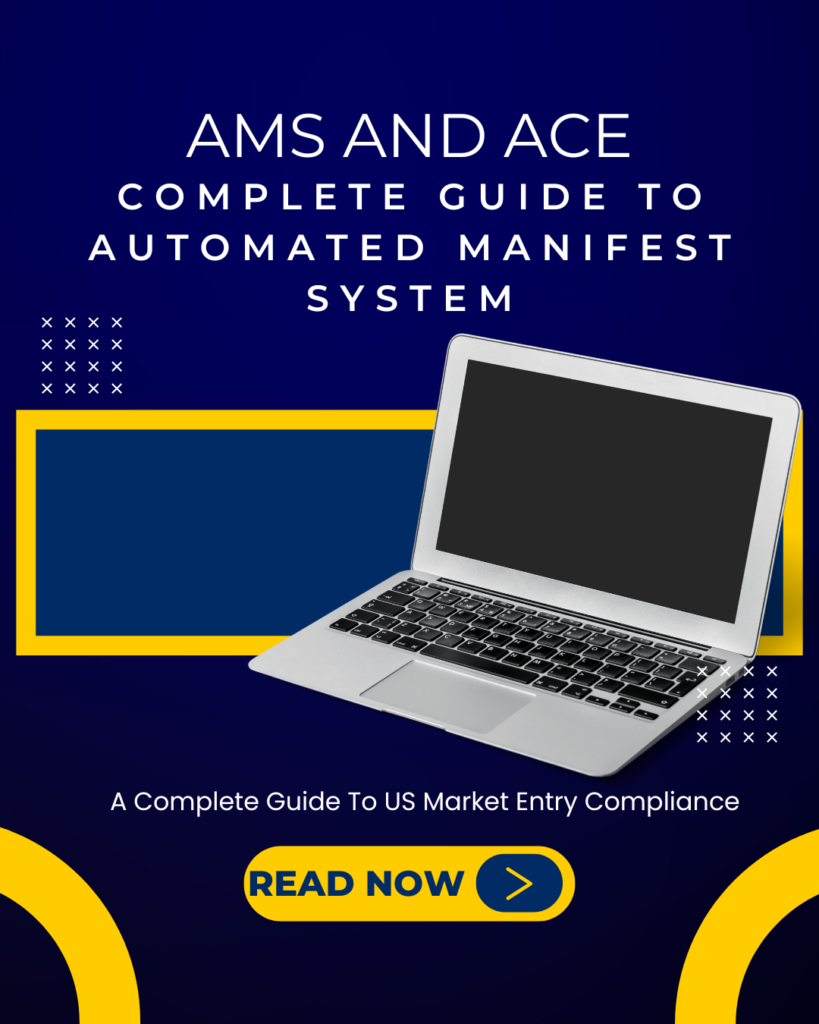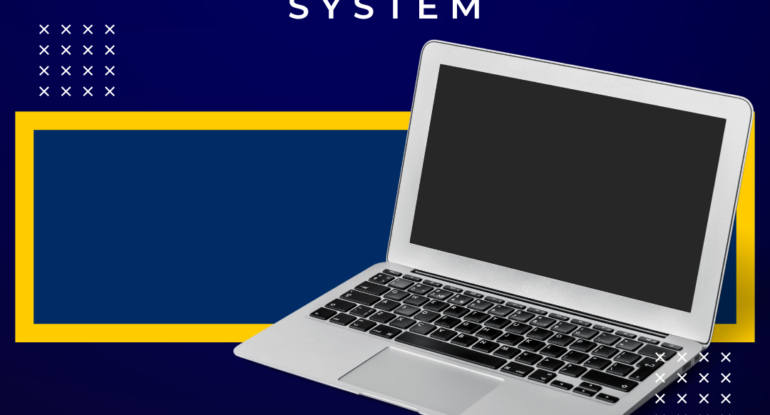AMS and US ACE: Complete Guide to Automated Manifest System and Customs Environment
What is AMS (Automated Manifest System)?
The Automated Manifest System (AMS) is an electronic data interchange system operated by U.S. Customs and Border Protection (CBP) that facilitates the advance submission of cargo information for shipments arriving in the United States. AMS enables carriers, freight forwarders, and customs brokers to submit manifest information electronically before a vessel, aircraft, or vehicle arrives at a U.S. port of entry.
This system is a critical component of U.S. customs operations and serves as the first line of security screening for incoming cargo. By requiring advance electronic filing, AMS allows CBP to identify high-risk shipments and perform security assessments before goods reach U.S. borders.

What is US ACE (Automated Commercial Environment)?
The US ACE (Automated Commercial Environment) is the primary system through which the trade community reports imports and exports and the government determines admissibility. US ACE was designed to replace older systems, consolidating and automating border processing to enable the efficient movement of goods across U.S. borders.
US ACE serves as the “single window” through which all import and export data is transmitted to CBP and participating government agencies. It streamlines trade processes, enhances security, and provides a unified platform for collecting, processing, and analyzing international trade data.
How Do AMS and US ACE Work Together?
AMS and US ACE work together as complementary systems in the U.S. import process:
- AMS focuses specifically on the advance submission of cargo manifest information
- US ACE is the broader system that handles the entire import/export process
In practice, manifest data submitted through AMS feeds into the US ACE system, where it’s integrated with other import information and made available to CBP and Partner Government Agencies (PGAs) for review and processing.
Who Needs to File AMS?
Is AMS filing mandatory for all shipments to the US?
Yes, AMS filing is mandatory for all commercial shipments entering the United States, regardless of transportation mode. The requirement applies to:
- Ocean carriers (Sea AMS)
- Airlines (Air AMS)
- Rail carriers (Rail AMS)
- Trucking companies (Truck AMS)
- NVOCCs (Non-Vessel Operating Common Carriers)
- Freight forwarders (when acting as carriers)
When do I need to file AMS for my shipment?
AMS filing deadlines vary based on the mode of transportation:
- Ocean freight: 24 hours before vessel loading at the foreign port
- Air freight: 4 hours prior to arrival for most flights; 4 hours before departure for flights from nearby areas
- Rail freight: 2 hours prior to arrival at the U.S. border
- Truck freight: 1 hour prior to arrival at the border for FAST (Free and Secure Trade) participants; 30 minutes for other carriers
Filing within these timeframes is crucial to avoid delays, holds, or potential penalties.
What Information is Required for AMS Filing?
What data elements must be included in an AMS filing?
A complete AMS filing must include:
- Carrier Information:
- SCAC code (Standard Carrier Alpha Code)
- Carrier name and contact details
- Vessel name and voyage number (for ocean shipments)
- Flight information (for air shipments)
- Cargo Details:
- Bill of lading or airway bill number
- Container numbers
- Seal numbers
- Cargo description (must be specific, not general)
- Cargo quantity and measurements
- Hazardous material indicators (if applicable)
- Trading Partner Information:
- Shipper name and address
- Consignee name and address
- Notify parties
- Consolidator information (for consolidated shipments)
- Routing Information:
- Port of loading
- Port of discharge
- Estimated arrival date and time
- Additional Data:
- FROB cargo indicators (Freight Remaining On Board)
- In-bond information (if applicable)
Why is accurate cargo description important in AMS filing?
Accurate cargo descriptions are critical in AMS filings because:
- Generic descriptions like “general merchandise,” “FAK” (Freight All Kinds), or “STC” (Said to Contain) are not acceptable
- CBP uses cargo descriptions to assess risk and determine if physical inspection is necessary
- Inaccurate descriptions can lead to shipment holds, penalties, or increased scrutiny on future shipments
- Descriptions should be specific, identifying exactly what the product is and its intended use
What is the Difference Between AMS and ISF?
How does AMS differ from Importer Security Filing (ISF)?
While both AMS and ISF are advance filing requirements for U.S. imports, they differ in several key ways:
| AMS | ISF |
| Filed by carriers, NVOCCs, or their agents | Filed by importers or their agents |
| Focuses on carrier and cargo manifest data | Focuses on supply chain information |
| Required for all modes of transportation | Required only for ocean freight |
| Different timing requirements based on transport mode | Must be filed 24 hours before vessel loading |
| Contains details about the shipment and routing | Contains details about the parties involved in the transaction |
Both filings are required for ocean shipments, and they work together to provide CBP with comprehensive information about incoming cargo.
How to Access US ACE for AMS Filing
What do I need to start filing AMS as a Freight Forwarder?
To begin filing AMS as a freight forwarder, you’ll need to obtain:
- SCAC Code (Standard Carrier Alpha Code) – This unique identifier is issued by the National Motor Freight Traffic Association and is essential for all AMS filings.
- Customs Type 3 Bond – This international carrier bond provides financial security to CBP, guaranteeing payment of duties, taxes, and potential penalties related to your shipments. The minimum coverage typically starts at $50,000, though the specific amount may vary based on your shipping volume.
- ACE Portal Account – You’ll need to register for access to the Automated Commercial Environment portal where filings are submitted.
- EDI Capability – Either develop in-house Electronic Data Interchange capabilities or contract with a service provider like G.O.L that can help you setup within 24 hours to transmit the required data formats.
Once these prerequisites are in place, you can begin start filing AMS to US CBP.
I don’t have these things and my shipment is on the way. What can I do?
If your shipment is already en route and you don’t have the necessary AMS filing credentials, there’s no need to panic. A common industry practice is to authorize AMS filing to licensed freight forwarders, customs brokers, or compliance advisors like G.O.L.
We offer immediate filing solutions that help you urgently comply with US customs regulations without delaying your shipments. Our team can quickly process your filing requirements using our established credentials and systems.
Please contact us immediately with your shipment details for urgent assistance.
Can small businesses directly file AMS or should they use a service provider?
While small businesses can technically establish direct AMS filing capabilities, many choose to use service providers for several reasons:
- Cost-effectiveness: Setting up an in-house EDI system requires significant investment
- Technical expertise: Maintaining the required technical infrastructure and staying current with CBP requirements demands specialized knowledge
- Volume considerations: The expense of direct filing is typically justified only for businesses with very high shipping volumes
- Compliance assurance: Service providers specialize in maintaining regulatory compliance and reducing the risk of errors
For most small to medium-sized businesses, working with a qualified service provider offers the most practical approach to AMS compliance.
Common AMS Filing Errors and How to Avoid Them
What are the most common errors in AMS filings?
The most frequent AMS filing errors include:
- Insufficient cargo descriptions
- Using general terms like “consolidated cargo” instead of specific descriptions
- Solution: Provide detailed, specific descriptions of the actual commodities
- Late submissions
- Filing after the required deadline for the transportation mode
- Solution: Implement procedures to ensure timely filing, accounting for potential delays
- Incorrect or missing container/equipment numbers
- Typographical errors or omitted information
- Solution: Verify all equipment numbers against shipping documents
- Inaccurate weight or quantity information
- Discrepancies between manifest and actual cargo
- Solution: Implement verification procedures for all measurements
- Missing or incorrect SCAC codes
- Using expired or invalid carrier identification
- Solution: Maintain updated carrier information and verify SCAC validity
What happens if there’s an error in my AMS filing?
Errors in AMS filings can lead to:
- Cargo holds: CBP may place shipments on hold pending resolution
- Examination orders: Errors may trigger physical inspection of cargo
- Penalties: Serious or repeated violations can result in monetary penalties
- Delays: Even minor errors can cause significant shipment delays
- Increased scrutiny: A history of errors may lead to heightened examination rates for future shipments
To minimize these consequences, implement rigorous verification processes and consider working with experienced service providers who specialize in AMS filings.
AMS Filing for Different Transportation Modes
How does AMS filing differ for ocean, air, rail, and truck shipments?
AMS filing requirements vary by transportation mode:
Ocean AMS (Sea AMS)
- Filed 24 hours before vessel loading
- Requires vessel and voyage details
- Must include detailed container information
- Typically handled by ocean carriers or NVOCCs
Air AMS
- Filed 4 hours before arrival (or before departure for flights from nearby areas)
- Requires flight and air waybill information
- Often handled by airlines or air freight forwarders
- Integrated with the Air Cargo Advance Screening (ACAS) program
Rail AMS
- Filed 2 hours before arrival at U.S. border
- Requires rail car information
- Typically handled by rail carriers
- Includes hazardous materials indicators when applicable
Truck AMS
- Filed 1 hour before arrival for FAST participants; 30 minutes for others
- Requires driver, vehicle, and cargo information
- Often integrated with other cross-border programs like C-TPAT
- May be filed through transponders at some border crossings
US ACE Features and Benefits
What are the key features of the US ACE system?
The US ACE system offers numerous features designed to streamline import and export processes:
- Centralized Access
- Single portal for all trade transactions
- Unified interface for multiple government agencies
- Consistent data standards across operations
- Electronic Documentation
- Paperless processing of trade documents
- Digital validation of submissions
- Electronic recordkeeping capabilities
- Automated Risk Assessment
- Integrated targeting capabilities
- Automated checks against security criteria
- Reduced inspection burden for low-risk shipments
- Real-time Status Updates
- Track processing status of entries
- Receive notifications of holds or examinations
- Monitor release status of shipments
- Data Analytics
- Access to trade statistics
- Historical transaction records
- Compliance measurement reporting
What are the benefits of the US ACE system for importers and exporters?
US ACE provides significant advantages for international trade participants:
- Increased Efficiency
- Reduced processing times
- Fewer data entry requirements
- Streamlined communications with government agencies
- Cost Reduction
- Lower document processing costs
- Reduced demurrage and storage expenses
- Decreased compliance management overhead
- Improved Compliance
- Consistent application of trade regulations
- Reduced error rates through data validation
- Enhanced visibility into compliance requirements
- Better Supply Chain Visibility
- End-to-end tracking of shipments
- Improved predictability of clearance times
- Enhanced coordination with trading partners
- Competitive Advantage
- Faster time to market
- Improved customer service
- More reliable delivery schedules
AMS and US ACE Best Practices
What are the best practices for efficient AMS and US ACE filing?
To optimize your AMS and US ACE processes:
- Establish Standard Operating Procedures
- Document clear processes for gathering and validating data
- Create checklists for required information
- Develop contingency plans for system outages or errors
- Invest in Training
- Ensure all staff understand filing requirements
- Stay current with regulatory changes
- Participate in CBP webinars and industry forums
- Leverage Technology
- Use integrated systems where possible
- Implement data validation tools
- Consider specialized software for high volumes
- Build Strong Relationships
- Develop good communication with CBP personnel
- Join industry associations for insights
- Establish clear channels with partners and service providers
- Conduct Regular Audits
- Review filing accuracy periodically
- Track and analyze error patterns
- Implement continuous improvement initiatives
How can I stay updated on AMS and US ACE regulation changes?
Staying current with AMS and US ACE requirements is essential:
- Subscribe to CBP communications
- CSMS (Customs and Border Protection Messaging Service)
- ACE Outreach newsletters
- Trade.gov updates
- Join industry associations
- NCBFAA (National Customs Brokers & Forwarders Association of America)
- AAEI (American Association of Exporters and Importers)
- Local trade organizations
- Establish relationships with CBP Client Representatives
- Schedule regular consultations
- Participate in CBP-led training sessions
- Engage in the Automated Commercial Environment (ACE) Account Portal
- Follow trade publications
- American Shipper
- Journal of Commerce
- Supply Chain Dive
- Work with knowledgeable service providers
- Leverage the expertise of customs brokers and consultants
- Participate in provider-led webinars and updates
- Request regular compliance briefings
Expert AMS Filing Services to Streamline Your US Imports
At GOL Solution, we specialize in providing comprehensive AMS filing and US ACE services to ensure your shipments move smoothly into the United States without delays or compliance issues.
What is the AMS Filing Process if I use G.O.L Filing service?
G.O.L offers two comprehensive service options for AMS filing:
Self-Service Option: We provide access to our AMS filing system, giving you autonomous control over how and when you file. This option is ideal for companies with in-house expertise who need reliable filing infrastructure.
Done-for-You Service: Our team acts as an extension of your compliance department, managing the entire filing process and ensuring all submissions are completed before regulatory deadlines. This hands-off approach allows you to focus on your core business while we handle compliance requirements.
To get started with either service, simply:
- Send an email to clients@golsolution.com
- Include the following essential documents:
- Bill of lading
- Commercial invoice
- Carrier SCAC information
Our team will promptly process your request and initiate the appropriate filing procedures.
Do I need to file AMS as a co-loader?
If you are a co-loader to a shipment and there is an NVOCC handling your shipment, the NVOCC will typically manage the AMS filing responsibility. In this scenario, you would provide the necessary shipment details to the NVOCC, who then incorporates your cargo information into their AMS filing.
However, it’s important to verify this arrangement explicitly with your NVOCC partner to ensure compliance responsibility is clearly established.
Can I authorize carriers to file AMS on my behalf?
Your AMS filing requirements depend on your documentation structure:
If you issue your own House Bill of Lading, you are required to file AMS directly or through an authorized representative like G.O.L.
If you prefer to avoid AMS filing responsibility, you can choose to operate under a Direct Master Bill of Lading arrangement, where only the carrier issues a Bill of Lading. In this scenario, the carrier assumes responsibility for AMS filing.
This choice impacts not only compliance requirements but also your level of control over the shipment documentation, so it’s important to consider your business needs when deciding between these options.
Our AMS and US ACE Expertise
With extensive experience in international trade compliance, we offer:
- Complete AMS Filing System that integrates seamlessly with your shipping processes
- Dedicated Filing Services handling all transportation modes (ocean, air, rail, and truck)
- Expert Troubleshooting to resolve filing errors or CBP concerns quickly
- Real-time Monitoring of filing status and customs responses
Proven Results
Our track record speaks for itself:
- Successfully process over 20,000 filing transactions annually to US Customs
- Maintain a 99.7% error-free filing rate, minimizing delays and holds
- Support clients across diverse industries including food & beverage, electronics, textiles, and more
- Provide 24/7 support for urgent filing needs and time-sensitive shipments
Why Choose Our AMS and US ACE Services?
- Deep Regulatory Expertise: Our specialists stay current with all CBP requirements and updates
- Efficient Processes: Our streamlined systems minimize the information required from you
- Cost-Effective Solutions: Avoid the expense of in-house filing capabilities
- Reduced Risk: Minimize the chance of costly delays and penalties
- Peace of Mind: Focus on your core business while we handle compliance concerns
Ready to Simplify Your US Customs Process?
Contact us today to learn how our AMS filing services can help you navigate the complexities of US Customs requirements with confidence and efficiency. Our team is ready to support your international shipping needs with expert guidance and reliable filing services.



